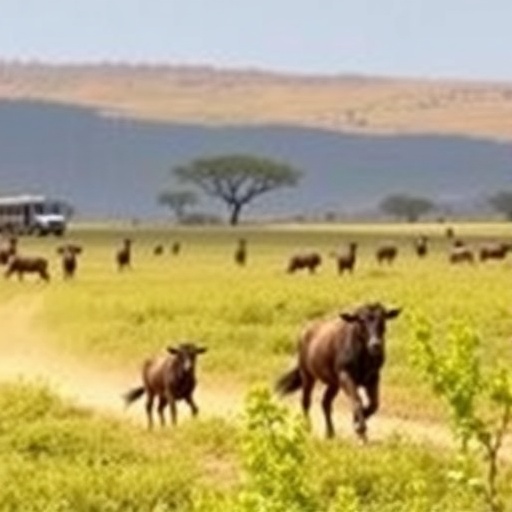In the heart of the Gambella region, South-West Ethiopia, a transformative pattern of seasonal migration among pastoralists is capturing the attention of researchers and policymakers alike. This remarkable phenomenon is deeply intertwined with the social, economic, and environmental dynamics of the region, revealing intricate relationships that shape the lives of communities dependent on livestock. The ongoing research by Gatdet, C., Adino, K., and Petros, T. sheds light on the complexities of these migrations, offering valuable insights into the practices that have sustained pastoralist lifestyles for generations.
The Gambella region, characterized by its diverse ecosystems and cultural richness, serves as a crucial habitat for various pastoralist groups. These communities, known for their adaptability and resilience, navigate the challenges posed by climate variability, land use changes, and socio-economic pressures. As the research illustrates, this journey is not merely a seasonal movement but a deeply ingrained cultural practice that reflects the historical and contextual narratives of the pastoralists.
Climate patterns fundamentally influence the dynamics of seasonal migration, dictating the availability of resources and shaping the migratory routes taken by pastoralists. As seasons change, so do the grazing patterns and water sources, which necessitate migration to sustain livestock herds. The research highlights how pastoralists have honed their understanding of ecological conditions over the years, enabling them to make informed decisions about when and where to migrate. By combining traditional knowledge with contemporary observations, these communities exhibit an impressive ability to adapt to shifting environmental conditions.
Additionally, the socio-political landscape plays a pivotal role in shaping migration patterns among pastoralists. Historical context, land tenure policies, and governance structures significantly impact the rights and access that pastoralists have to migratory routes and grazing lands. The study reveals how conflicts over resources, often fueled by land competition, can disrupt traditional migration patterns and exacerbate tensions among communities. Understanding these political dimensions is crucial for developing interventions that promote peaceful coexistence and sustainable resource management.
Economic factors also emerge as significant motivators for seasonal migration. The quest for better grazing opportunities often intertwines with the search for market access, where pastoralists strive to secure favorable prices for their livestock and fodder. Findings from the research indicate that migration is not solely a response to environmental pressures but also a strategic economic choice that can enhance livelihoods. By migrating to different regions, pastoralists tap into diverse markets and strengthen their economic resilience.
Cultural dimensions underpinning these migrations reveal a rich tapestry of social interactions and networks among pastoralist communities. Seasonal migrations are often accompanied by social gatherings, marriages, and exchange of cultural practices, reinforcing bonds between different groups. This aspect of migration fosters a sense of unity and collaboration among pastoralists, enhancing their social capital. Despite the challenges posed by modernity, the resilience of these social networks remains evident, and the research highlights the importance of preserving these cultural practices as a means of sustaining pastoralist identity.
The study also underscores the impact of modernization and technological advancements on pastoralist migration. The increasing availability of mobile communication technologies has transformed how pastoralists manage their migratory routes and stay informed about environmental changes. By leveraging technology, these communities can coordinate movements more effectively, share knowledge, and access markets beyond their immediate geographical boundaries. The integration of modern tools with traditional practices represents a promising avenue for enhancing the adaptability of pastoralists in an ever-changing world.
However, the dynamics of seasonal migration are not without challenges. Environmental degradation, driven by climate change and human activities, threatens the very foundations of pastoralist livelihoods. As resources become scarcer, competition intensifies, and traditional migration routes may be disrupted. The research highlights the urgency of addressing these environmental concerns through effective policy measures that prioritize sustainable land use and conservation efforts, ensuring that pastoralists can continue to thrive in their ancestral homelands.
Moreover, the research contributes to a broader understanding of migration patterns globally, illuminating the interconnectedness of local actions and global trends. As pastoralists migrate across boundaries, they reflect larger trends of human mobility influenced by economic opportunities, climate change, and social dynamics. Understanding these patterns can inform not only local policies but also international discussions surrounding migration, climate adaptation, and development strategies.
In conclusion, the dynamics of seasonal migration among pastoralists in the Itang special district of the Gambella region are a testament to the resilience and adaptability of these communities. The ongoing research by Gatdet, Adino, and Petros serves as a critical reminder of the importance of respecting traditional knowledge and practices while addressing the challenges posed by modernity and environmental change. As the world grapples with the complexities of migration, the experiences of pastoralists offer valuable lessons in sustainability, resilience, and the profound connections between people and their landscapes.
This intricate tapestry of life in Itang not only highlights the struggles but also the ingenuity of pastoralists as they navigate a changing world. As the future unfolds, the wisdom gleaned from these seasonal migrations will be instrumental in fostering a deeper understanding of sustainable practices that promote harmony between communities and the environment. The journey continues, and as these pastoralists traverse the lands, they carry with them the stories of resilience and hope that resonate far beyond the borders of their region.
Subject of Research: Dynamics of seasonal migration among pastoralists in Itang special district, Gambella region, South–West Ethiopia.
Article Title: Dynamics of seasonal migration among pastoralists in Itang special district, Gambella region, South–West Ethiopia.
Article References: Gatdet, C., Adino, K. & Petros, T. Dynamics of seasonal migration among pastoralists in Itang special district, Gambella region, South–West Ethiopia. Discov Sustain 6, 890 (2025). https://doi.org/10.1007/s43621-025-01681-0
Image Credits: AI Generated
DOI:
Keywords: Seasonal migration, pastoralists, Gambella region, climate change, socio-economic dynamics, cultural practices, modernization, resilience, sustainability.




